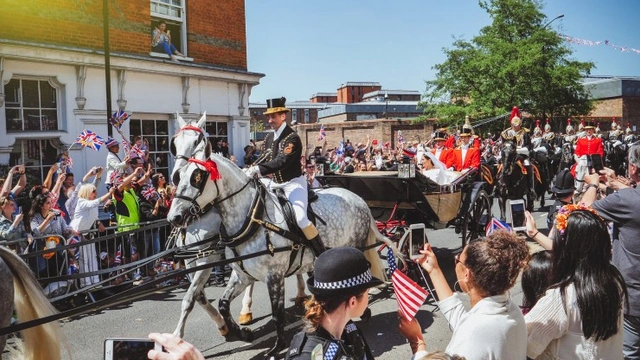
All the Queens’ Horses
With a recent royal wedding very much to the fore, there has been particular focus on pageantry and tradition and a lot of coverage and emphasis on the Queens’ horses.
The wedding between Prince Harry and Meghan Markle was a showcase event for the horses of the Royal Household. The actual carriage occupied by the couple after the ceremony during their tour of Windsor, was an open top Ascot Landau pulled by four Windsor Greys with a further two Windsor Greys acting as outriders.
The Windsor Grey is not actually a breed in its own right but is the term used to describe the grey horses of the Royal Household which are used on state and ceremonial occasions. The Windsor Greys are stabled at the Royal Mews in London and are grey horses selected for their temperament and appearance. The chosen horses are broken to saddle before being broken to harness as their ceremonial duties will involve being both ridden and driven in turn. A life-sized statue of two Windsor Greys, Storm and Daniel, was commissioned in 2013 and unveiled in Windsor to celebrate the Queens’ Diamond Jubilee.
The other main carriage horses of the Royal Household are Cleveland Bays and, as their name suggests, are bay in colour with minimal or no white markings. Once a popular driving horse, these horses originated in the north of England derived from the Chapman Horse bred in the Cleveland Hills during the seventeenth century. Initially used by the farming community, they developed into road horses, so not only pulling vehicles but also as pack horses. Introducing Arab and Thoroughbred blood produced the taller horse you see today and they were a popular riding horse and hunter after the war, making an excellent first cross with the Thoroughbred to produce a sports horse with strength, bone and quality.
Their popularity of the Cleveland Bay as a riding horse has diminished over the years due in no small part to the rise of the modern warmblood. The support of the Royal Household for the Cleveland Bay has therefore proved to be something of a godsend. The breed is listed by the Rare Breeds Survival Trust in 2018 on their Danger List with just 64 registered breeding females left.
The other horses that appeared in Windsor on May 19th at Harry and Meghan’s wedding were the horses of the Household Cavalry Mounted Regiment; they provided an escort to the carriage on its tour through Windsor. The Household Cavalry Mounted Regiment is part of the British Army and now largely performs ceremonial duties. They are not to be confused with the Household Cavalry Regiment which does has frontline combat duties.
The horses used in the mounted division are called ‘Irish Blacks’ and that is because they are all very dark brown or black and originate in the main from Ireland. They are largely of a draught background and are sourced by the Army as three or four year olds and brought into training at an early age.
The other mounted ceremonial unit of the British Army is the King’s Troop Royal Horse Artillery. The King’s Troop are famed for providing gun salutes on ceremonial occasions as the horses parade with guns from the First World War. Each unbraked gun is pulled by six horses called gun team horses which are smaller and stockier to accommodate the gun carriage harness. The Troop also has chargers which are larger horses, ridden during ceremonial occasions and the world famous Musical Ride. The King’s Troop has between 130 and 140 horses at their barracks in London at any given moment. They also provide a team of black horses and a gun carriage for state and military funerals.
In addition to the famous ceremonial horses, the Queen also has her own private leisure and sports horses dotted at different locations around the country. There is a Royal Stud at Sandringham which was established in 1886 by Edward, Prince of Wales where Thoroughbreds are produced for the racecourse. And a Highland Pony Stud at Balmoral Castle – the Queen is a huge supporter of the breed. The Queen also breeds and owns riding horses and has several with top showing producer, Kate Jerram, who is based in Essex.
The Royal family has been involved in many equestrian disciplines over the years from racing through to polo, showing and driving and this is all in addition to the horses they keep for state and ceremonial occasions. Their unwavering support for the horse in all its many roles is a key part of their national identity and forms a large part of the affection that the British people hold for them and their equestrian traditions.



